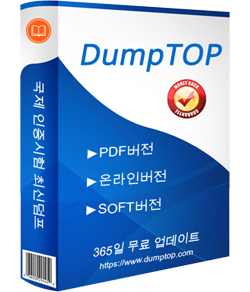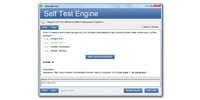우리의 TOGAF Enterprise Architecture Combined Part 1 and Part 2 Exam 시험 덤프 문제는 최고품질의 시험대비 자료입니다. 전문가들이 최신 실러버스에 따라 몇년간의 노하우와 경험을 충분히 활용하여 연구제작해낸 자료라 해당 시험의 핵심문제를 모두 반영하고 있습니다.OGEA-103 덤프로 시험을 준비하시면 시험패스는 더는 어려운 일이 아닙니다. OGEA-103 시험에서 출제 가능성이 높은 문제만 정리한 최신 버전 자료라 가장 적은 문항수로 모든 응시자가 효율적인 시험공부를 할 수 있도록 하고 부담 없이 한번에 OGEA-103 시험을 즉시 통과할 수 있도록 도와드립니다.
간결한 내용
OGEA-103 덤프문제는 다년간의 다양한 시험에 대한 분석을 바탕으로, 시험문제의 주요 발전 경향에 따라 응시자가 직면할 어려움을 정면 돌파하기 위하여 전문가들이 자신만의 경험과 끊임없는 노력으로 제작한 최고품질의 시험자료입니다.다른 교육 플랫폼과 달리 TOGAF Enterprise Architecture Combined Part 1 and Part 2 Exam 시험덤프는 오래된 문제는 삭제하고 새로운 문제는 바로바로 추가하여 덤프가 항상 가장 최신버전이도록 간결하고 눈에 잘 띄는 텍스트로 요약되어 있기에 덤프만 완벽하게 마스터 하시면 OGEA-103 시험패스는 더는 어려운 일이 아닙니다.
커리큘럼 소개
대부분의 분들에게 있어서 자격증 시험이 처음일 수 있으므로 자격증 시험과 관련된 많은 정보는 복잡하고 난해할수 있습니다. 하지만 자격증 취득 초보자들의 덤프공부 후기에 따르면 OGEA-103 덤프는 시험의 모든 출제범위와 시험유형을 커버하고 있어 덤프에 있는 문제와 답만 기억하시면 TOGAF Enterprise Architecture Combined Part 1 and Part 2 Exam 시험을 쉽게 패스하여 자격증을 취득할수 있다고 합니다. OGEA-103 시험대비 덤프는 초보자의 눈높이에 맞추어 덤프를 사용하시는 분께서 보다 편하게 공부할수 있도록 엘리트한 전문가들의 끊임없는 연구와 자신만의 노하우로 최선을 다한 자료입니다.덤프의 도움으로 여러분은 업계에서 또 한층 업그레이드 될것입니다.
진정한 시뮬레이션 환경
많은 응시자 분들이 처음 자격증 시험에 도전하는 것이라 시험보실 때 경험 부족으로 인해 시험시간에 너무 긴장하여 평소 실력을 발휘하지 못하는 경우가 있습니다.이를 피면할수 있도록 미리 TOGAF Enterprise Architecture Combined Part 1 and Part 2 Exam 시험과 비슷한 환경에서 연습하는 훈련을 통해 실제 시험에서 긴장을 완화시키는 것이 좋습니다. 저희는OGEA-103 실제 시험 시뮬레이션 테스트 환경에 해당하는 제품을 가지고 있습니다. 제품 구매후 자신의 계정에 로그인하시고 실제 시험 환경을 체험해 보시면 시험 환경에 적응되어 OGEA-103 시험보실때 문제 푸는 방법을 모색하는 시간이 줄어들어 자신감이 생겨 한방에 시험패스 가능할것입니다.
최신 Enterprise Architecture OGEA-103 무료샘플문제:
1. Complete the sentence. Actions arising from the Business Transformation Readiness Assessment technique should be incorporated in the
A) Architecture Requirements Specification
B) Implementation and Migration Plan
C) Architecture Roadmap
D) Implementation Governance Model
2. Please read this scenario prior to answering the question
Your role is that of a senior architect, reporting to the Chief Enterprise Architect, at a medium-sized company with 400 employees. The nature of the business is such that the data and the information stored on the company systems is their major asset and is highly confidential.
The company employees travel extensively for work and must communicate over public infrastructure using message encryption, VPNs, and other standard safeguards. The company has invested in cybersecurity awareness training for all its staff. However, it is recognized that even with good education as well as system security, there is a dependency on third-parly suppliers of infrastructure and software.
The company uses the TOGAF standard as the method and guiding framework for its Enterprise Architecture (EA) practice. The CTO is the sponsor of the activity.
The Chief Security Officer (CSO) has noted an increase in ransomware (malicious software used in ransom demands) attacks on companies with a similar profile. The CSO recognizes that no matter how much is spent on education, and support, it is likely just a matter of time before the company suffers a significant attack that could completely lock them out of their information assets.
A risk assessment has been done and the company has sought cyber insurance that includes ransomware coverage. The quotation for this insurance is hugely expensive. The CTO has recently read a survey that stated that one in four organizations paying ransoms were still unable to recover their data, while nearly as many were able to recover the data without paying a ransom. The CTO has concluded that taking out cyber insurance in case they need to pay a ransom is not an option.
Refer to the scenario
You have been asked to describe the steps you would take to improve the resilience of the current architecture?
Based on the TOGAF standard which of the following is the best answer?
A) You would request an Architecture Compliance Review with the scope to examine the company's resilience to ransomware attacks. You would identify the departments involved and have them nominate representatives. You would then tailor checklists to address the requirement for increased resilience. You would circulate to the nominated representatives for them to complete. You would then review the completed checklists, identifying and resolving issues. You would then determine and present your recommendations.
B) You would determine business continuity requirements, and undertake a gap analysis of the current Enterprise Architecture. You would make recommendations for change requirements to address the situation and create a change request. You would manage a meeting of the Architecture Board to assess and approve the change request. Once approved you would produce a new Request for Architecture Work to activate an ADM cycle to carry out a project to define the change.
C) You would ensure that the company has in place up-to-date processes for managing change to the current Enterprise Architecture. Based on the scope of the concerns raised you recommend that this be managed at the infrastructure level. Changes should be made to the baseline description of the Technology Architecture. The changes should be approved by the Architecture Board and implemented by change management techniques.
D) You would monitor for technology changes from your existing suppliers that could improve resilience.
You would prepare and run a disaster recovery planning exercise for a ransomware attack and analyze the performance of the current Enterprise Architecture. Using the findings, you would prepare a gap analysis of the current Enterprise Architecture. You would prepare change requests to address identified gaps. You would add the changes implemented to the Architecture Repository.
3. The_________________ensures that a project transitioning into implementation also smoothly transitions into appropriate Architecture Governance.
A) Migration Plan
B) Implementation Strategy
C) Transition Plan
D) Implementation Governance Model
4. Which of the following statements about architecture partitioning are correct*?
1 Partitions are used to simplify the management of the Enterprise Architecture
2 Partitions are equivalent to architecture levels
3 Partitions enable different teams to work on different element of the architecture at the same time.
4 Partitions reflect the organization's structure
A) 2 & 4
B) 2 & 3
C) 1 & 4
D) 1 & 3
5. Consider the following ADM phases objectives.
Which phase does each objective match?
A) 1C-2B-3A-4C
B) 1C-2D-3B-4A
C) 1B-2D-3A-4C
D) 1A-2B-3C-4D
질문과 대답:
| 질문 # 1 정답: B | 질문 # 2 정답: B | 질문 # 3 정답: D | 질문 # 4 정답: D | 질문 # 5 정답: A |


 445 고객 리뷰
445 고객 리뷰





